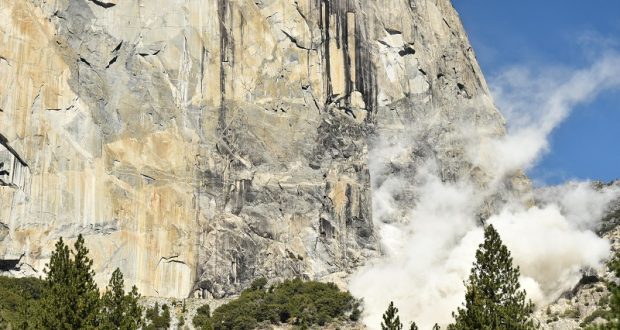By Greg M. Stock —
YOSEMITE — Recent earthquakes centered near Ridgecrest, CA, were strongly felt in and around Yosemite Valley.
The largest of these, a magnitude 7.1 earthquake at 8:19 p.m. on Friday, July 5, caused shaking of the floor of Yosemite Valley that lasted ten seconds. Despite this shaking, it seems that there were not any rockfalls triggered by these earthquakes.
Earthquakes are one of the most reliable rockfall triggers in Yosemite.
At 2:30 a.m. on March 26, 1872, John Muir awoke to strong ground shaking and, stepping outside of his cabin, observed a large rockfall sweeping down the cliff behind the Chapel — he could see it in the dark because of the sparking produced by pulverizing quartz. The Lone Pine earthquake, centered in the southern Owens Valley, was estimated to have been at least magnitude 7.4 and possibly as high as magnitude 7.9. Nine other large rockfalls were triggered by that earthquake, including one from Liberty Cap that generated an airblast that knocked Snow’s Hotel (formerly near the base of Nevada Falls) off of its foundation.
More recently, a series of earthquakes May 25-27, 1980, centered near Mammoth Lakes, CA, triggered many rockfalls in Yosemite Valley. The largest of these, a magnitude 6.3, triggered rockfalls from above the Sierra Point Trail, causing injuries and leading to the permanent closure of that trail.
Given this history of earthquake-triggered rockfalls, why is it that the strong ground shaking last week didn’t trigger rockfalls? The answer likely has to do with the sensitive relationship between earthquake magnitude and epicenter distance. The recent earthquakes were of a relatively large magnitude, but they were centered 175 miles away from Yosemite Valley, so their energy was greatly attenuated by the time it reached Yosemite. In contrast, the smaller Mammoth Lakes earthquakes were centered just 35 miles from Yosemite Valley, generating strong ground shaking and rockfalls. So although the recent earthquakes were widely felt in Yosemite Valley, the long distance to the epicenter translated into shaking was apparently not strong enough to trigger rockfalls.
Fortunately Yosemite Valley is a relatively low seismic hazard zone for California, but there are infrequent, large earthquakes along the eastern front of the range that could (will) trigger future rockfalls. If you experience strong ground shaking in Yosemite Valley, move away from the cliffs as quickly as you can.
Greg Stock is the park geologist at Yosemite



